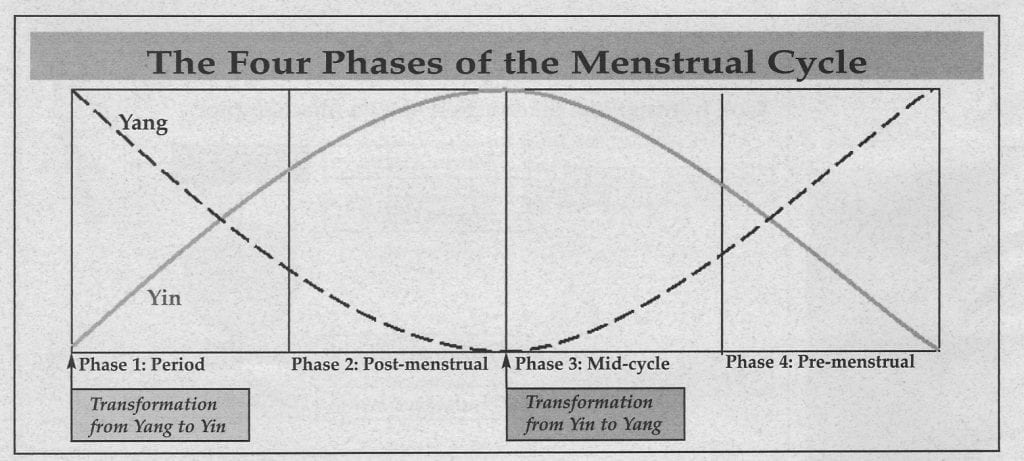WOMEN’S PHYSIOLOGY ACCORDING TO CHINESE MEDICINE
The Menstrual Cycle According to Chinese Medicine
For a monthly discharge of Blood from the uterus (menstruation) to take place, two things must occur. First, a “superabundance” of Blood must accumulate in the uterus. Eventually the uterus becomes full and the Blood “spills over” (this is the start of menstruation). Second, the Qi and Blood must be moving freely enough for the Blood to move down into the uterus and eventually overflow and be discharged from the body. Given these requirements, in order to understand the physiology of the menstrual cycle from the perspective of Chinese medicine, one has to consider the mechanism for Blood production, as well as what factors might inhibit the free movement of Qi and Blood.
Blood production
There are three organs that participate in the formation of Blood. The process starts at the Spleen, which is responsible for extracting the nutrients from food and drink (food Qi), which form the raw materials for the manufacture of Blood and Qi. If the Spleen’s ability to perform this function is weakened or if the diet is improper, Blood and Qi are likely to become deficient. The food Qi is then sent upward to the Heart, which combines food Qi from the Spleen with Kidney Essence to make Blood. Although food Qi is the primary component of Blood, the Kidney Essence is a critical ingredient. The situation can be compared to baking bread – the food Qi is like flour and water and the Kidney Essence is like yeast – both components are critical for the quality of the final product.
After the Blood is formed, the Heart is responsible for transporting it all over the body and down into the uterus. First the Blood is sent to the internal organs, then it goes to the channels and vessels to nourish and moisten all the body tissues. Finally, whatever Blood is left over is transported by the Heart down into the uterus.
So, if the Spleen fails to digest food and drink and form adequate food Qi, if the Kidney lacks sufficient Essence to send up to the Heart, or if the Heart is for any reason unable to perform its function of manufacturing Blood, then Blood becomes deficient and the menstrual cycle is affected.
The control of Blood
Although menstruation will not occur if there is insufficient Blood in the uterus, it may occur early or late or may be accompanied by pain if the Blood is not properly controlled.
The two organs that control the Blood are the Liver and the Spleen. One of the functions of the Spleen is to “restrain” the Blood, or keep the Blood within the vessels. When the restraining aspect of the Spleen function is weak, we see symptoms such as heavy menstrual bleeding, spotting before menstruation, or excessively long menstrual periods.
The Liver is in charge of smoothly distributing Qi and Blood to all the body tissues. The Liver is most commonly affected by stagnation caused by emotional factors and stress. When the Liver is stagnant, Blood and Qi are not evenly spread and menstrual symptoms such as cramping and blood clots in the flow occur.
Organ Function in Women’s Physiology
Adapted from The Infertility Cure by Randine Lewis, L.Ac., Ph.D., 2004.
Kidney
- Contains our genetic makeup
- Controls the reproductive system and a woman’s hormones
- Connects reproductive, skeletal, neurological, and endocrine systems
- Stores Essence, one of the key energies of the body
Spleen
- Governs energy production, metabolism, digestion, and elimination
- Converts nutrients into Qi and Blood
- Essential for healthy menstrual cycle
- Affects thyroid hormone production
- Sustains the luteal phase
Heart
- Governs the mind and spirit
- Controls Blood and circulatory systems
- Provides Blood for the uterus
Liver
- Controls the smooth flow and distribution of Blood
- Responsible for all transformations in the body, including ovulation
- Provides Blood for menstruation
- Affects the expression of emotions, calms emotional energy
- Stores Blood
Uterus
- “Palace of the Child”
- Connection with the rest of the body through the Heart and Kidneys
- Source of the Conception and Penetrating meridians
Penetrating meridian
- Communicates with other meridians
- Presides over menstruation and hormonal cycles
- Source of Conception and Governing meridians
Conception meridian
- Regulates the yin energy
- Supplies the Kidney, Liver, Spleen, Heart, Pericardium, and Lung organ systems
- Connected with the production of estrogen
Governing meridian
- Regulates yang energy
- Supplies the Urinary Bladder, Gall Bladder, Stomach, Small Intestine, Large Intestine, and San Jiao systems
- Oversees testosterone and progesterone production
Girdle meridian
- Encircles the body horizontally at the waist
- Binds the Penetrating, Conception, Kidney, Liver, and Spleen channels
- Restrains vaginal leakage, including miscarriage


